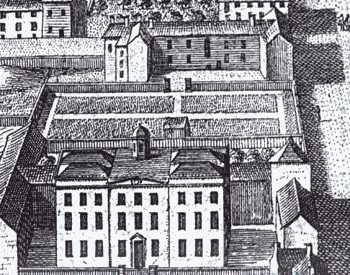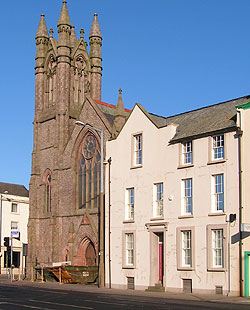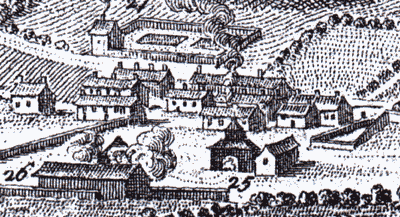
Walter Lutwidge was a prominent merchant in Whitehaven gaining most of his fortune from the tobacco trade in the early 18th century. We can get some idea of his success from the size of his house which can be seen on the 1738 view from Matthias Read and which was probably built 10 years earlier.

Not as large as the Cupola in the foreground the Lutwidge mansion behind was still one of the largest houses in Whitehaven. Although this shows the rear of the house it is clear to see the H shaped layout. The central range provided living accommodation with a central staircase and courtyards front and back where carriages and carts could decant their contents respectively. This is flanked by two large wings - the one on the Scotch Street side isn't heated and was probably a warehouse. The surviving wing provided more storage and office space.The wings actually look longer on the original painting creating a square court.
It occupied the site of what is now the old Methodist church on the corner of Lowther Street and Scotch Street. The first plot he acquired in 1716 was 75 yards deep with 44.5 yards facing Lowther Street and was later was added to. One wing of the house still survives and is incorporated into no.75 Lowther Street.

The surviving wing of the Lutwidge House. It is possible to imagine the size of the original house occupying all the plot containing the Methodist church.
Walter Lutwidge came to Whitehaven with possibly two brothers from Ireland and was master of a tobacco ship about 1708. He ended up with at least half a dozen ships and interest in many others. His business dealings did not finish there as we know he also helped to establish a factory producing glass bottles also seen on the Read painting.

Marked as 25 on Parr's engraving the bottle manufactory can be seen as a building housing the furnace with an attached house or warehouse and was in the area now known as the Ginns.
He also had a share in the Whitehaven Rope Company and by the 1740's accumulated several shops in the town. He had a brother called Thomas who was one of the principal importers of tobacco whose house was where the HSBC bank now is. There was also a James Lutwidge, probably a third brother, retired sailor who died in 1737. In 1746 when he passed the business to his son, also called Thomas, Walter estimated his own fortune at £30,000. In 1748 he became High Sheriff of Cumbria.
One of his son Thomas's daughters married John Cookson of Newcastle who was a cousin of William Wordsworth's mother Anne. Thomas also had a son called Thomas.
Eventually, the site of his house also housed the independent chapel behind the Methodists which would have no doubt pleased the Lutwidge family who were Presbyterians.
© WAWL 2006